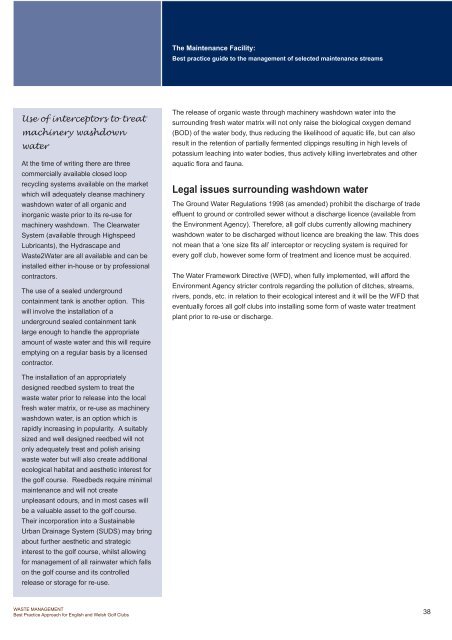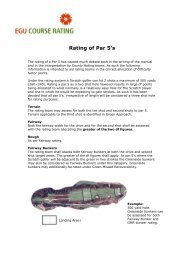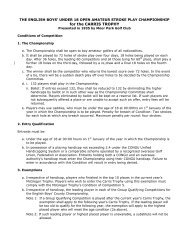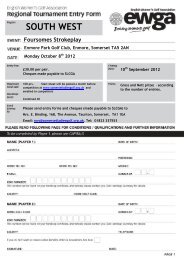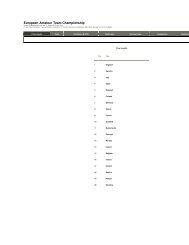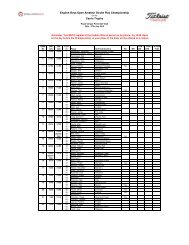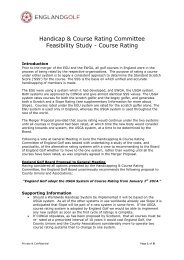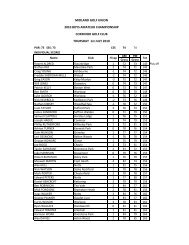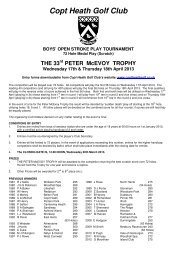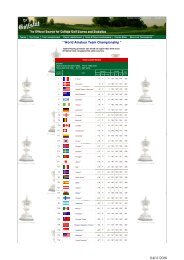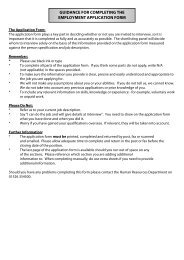Waste management - England Golf
Waste management - England Golf
Waste management - England Golf
Create successful ePaper yourself
Turn your PDF publications into a flip-book with our unique Google optimized e-Paper software.
The Maintenance Facility:<br />
Best practice guide to the <strong>management</strong> of selected maintenance streams<br />
Use of interceptors to treat<br />
machinery washdown<br />
water<br />
At the time of writing there are three<br />
commercially available closed loop<br />
recycling systems available on the market<br />
which will adequately cleanse machinery<br />
washdown water of all organic and<br />
inorganic waste prior to its re-use for<br />
machinery washdown. The Clearwater<br />
System (available through Highspeed<br />
Lubricants), the Hydrascape and<br />
<strong>Waste</strong>2Water are all available and can be<br />
installed either in-house or by professional<br />
contractors.<br />
The use of a sealed underground<br />
containment tank is another option. This<br />
will involve the installation of a<br />
underground sealed containment tank<br />
large enough to handle the appropriate<br />
amount of waste water and this will require<br />
emptying on a regular basis by a licensed<br />
contractor.<br />
The release of organic waste through machinery washdown water into the<br />
surrounding fresh water matrix will not only raise the biological oxygen demand<br />
(BOD) of the water body, thus reducing the likelihood of aquatic life, but can also<br />
result in the retention of partially fermented clippings resulting in high levels of<br />
potassium leaching into water bodies, thus actively killing invertebrates and other<br />
aquatic flora and fauna.<br />
Legal issues surrounding washdown water<br />
The Ground Water Regulations 1998 (as amended) prohibit the discharge of trade<br />
effluent to ground or controlled sewer without a discharge licence (available from<br />
the Environment Agency). Therefore, all golf clubs currently allowing machinery<br />
washdown water to be discharged without licence are breaking the law. This does<br />
not mean that a ‘one size fits all’ interceptor or recycling system is required for<br />
every golf club, however some form of treatment and licence must be acquired.<br />
The Water Framework Directive (WFD), when fully implemented, will afford the<br />
Environment Agency stricter controls regarding the pollution of ditches, streams,<br />
rivers, ponds, etc. in relation to their ecological interest and it will be the WFD that<br />
eventually forces all golf clubs into installing some form of waste water treatment<br />
plant prior to re-use or discharge.<br />
The installation of an appropriately<br />
designed reedbed system to treat the<br />
waste water prior to release into the local<br />
fresh water matrix, or re-use as machinery<br />
washdown water, is an option which is<br />
rapidly increasing in popularity. A suitably<br />
sized and well designed reedbed will not<br />
only adequately treat and polish arising<br />
waste water but will also create additional<br />
ecological habitat and aesthetic interest for<br />
the golf course. Reedbeds require minimal<br />
maintenance and will not create<br />
unpleasant odours, and in most cases will<br />
be a valuable asset to the golf course.<br />
Their incorporation into a Sustainable<br />
Urban Drainage System (SUDS) may bring<br />
about further aesthetic and strategic<br />
interest to the golf course, whilst allowing<br />
for <strong>management</strong> of all rainwater which falls<br />
on the golf course and its controlled<br />
release or storage for re-use.<br />
WASTE MANAGEMENT<br />
Best Practice Approach for English and Welsh <strong>Golf</strong> Clubs<br />
38


